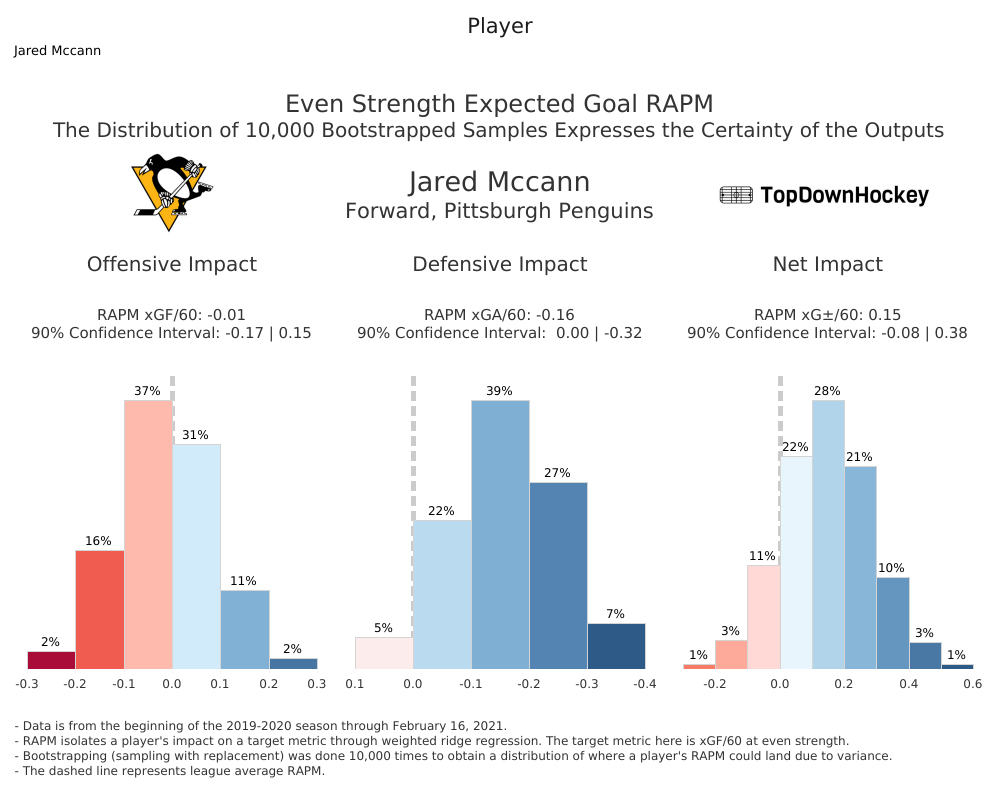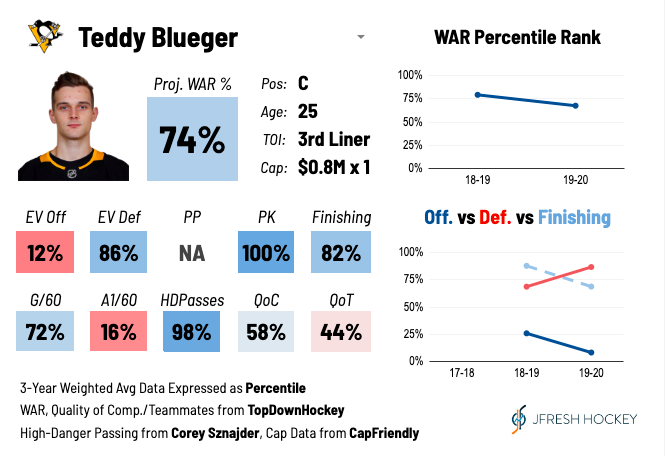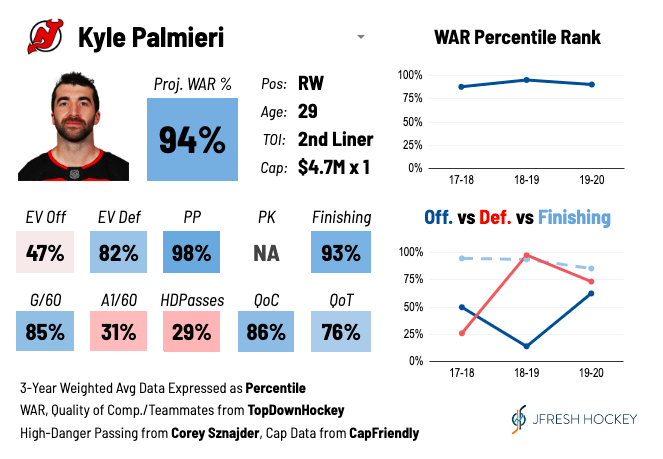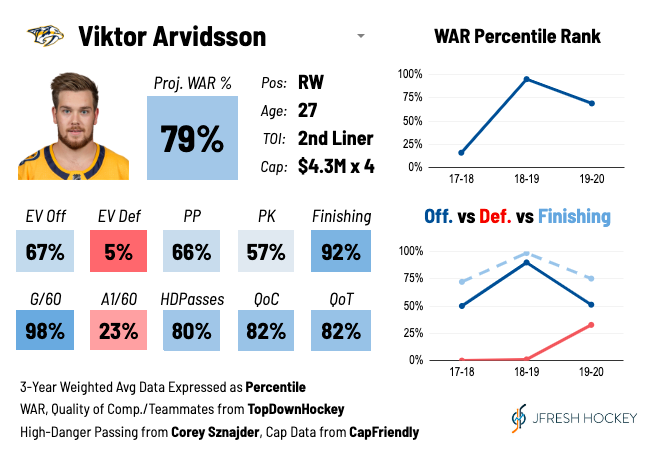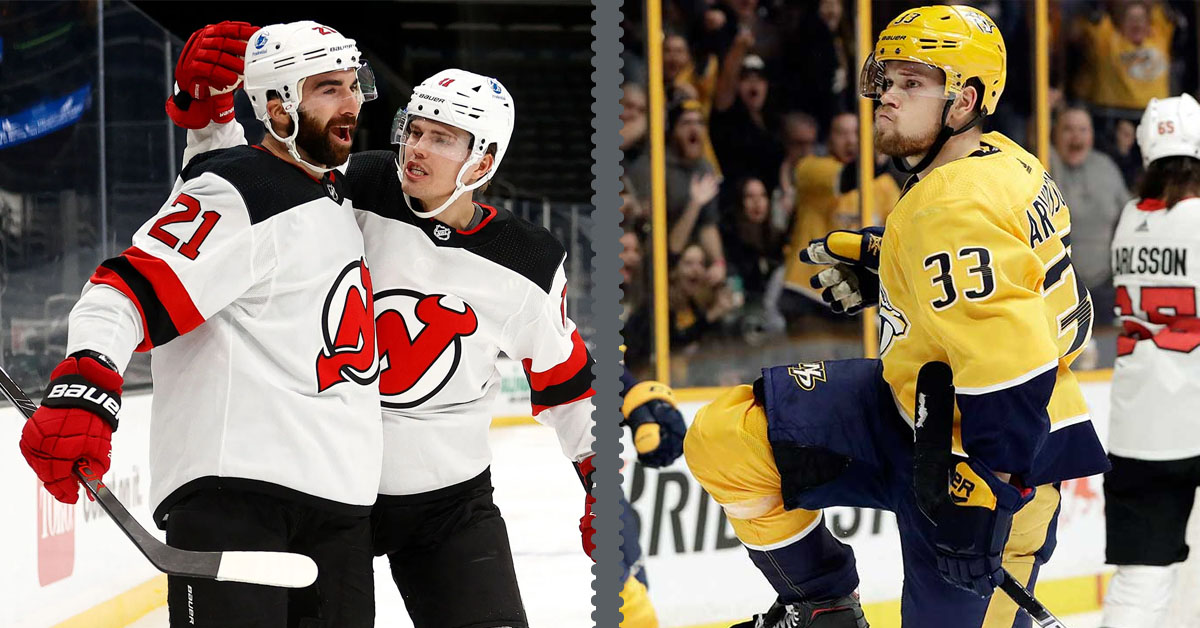
Mark Jankowski’s poor performance this season has rightfully sparked the debate about whether or not the Penguins need another center.
In the Penguins’ first two games of the season, Jankowski was on the ice for a total of 1.23 expected goals for at 5v5. Since then, in 14 games, Jankowski has been on the ice for 1.71 expected goals for, per Evolving Hockey.
We knew coming into the season that Jankowski was limited offensively, but that he was also pretty sturdy in his own end. That hasn’t been true this season. Penguins opponents are shooting the puck more when Jankowski is on the ice at 5v5 than any other forward that isn’t Drew O’Connor. The Penguins are conceding 2.49 expected goals against per hour with him on the ice at 5v5, fifth worst of the 15 Penguins forwards to play at least 50 minutes this season (EH).
With his inept offensive abilities, if he isn’t an absolute rock in his own end, he isn’t worth a spot in the lineup.
If Jankowski is coming out, that leaves Jared McCann, who hasn’t played center all season and is currently injured, and Teddy Blueger to fill out the Penguins’ center depth.
McCann has yet to re-join practice with the team but has been skating on his own and seems somewhat close to returning. We already know McCann is capable of filling the third line center role, albeit as more of a defensive presence that might give you a few goals off the rush.
Further cementing the claim that he’s equipped for the job, data scientist Patrick Bacon (TopDownHockey) created a confidence interval for his RAPM expected goals model and it is 95% certain that McCann has a positive impact on expected goals against and 85% certain that he has a positive net impact.
If RAPM and confidence intervals sound foreign to you, allow Patrick to break it down much more eloquently than I could. I highly suggest taking time to read it as well as Patrick’s other work if you are serious about understanding hockey analytics.
If the Penguins are hell-bent on keeping McCann out of the 3C role, Blueger remains a solid option. His trio with Brandon Tanev and Zach Aston-Reese has basically been deployed as the Pens’ third line anyway, and his impacts are nothing to scoff at.
Blueger is very solid defensively, but he isn’t much of an offensive play-driver. He is a better goal scorer than he’s given credit for and shockingly ranks in the 98th percentile in high-danger passes among NHL forwards over the past three seasons.
This season with Blueger on the ice at 5v5, the Penguins are scoring 57.4% of the goals, controlling 54.2% of the expected goals, and taking 51.4% of the shot attempts (EH). Though in years past his primary assist rate was toward the league’s bottom, this season he ranks 27th in primary assists per hour among forwards to play at least 100 minutes.
The Penguins and their fans might not like it, but they have in-house options that will do the job just fine, even though they might not be an offensive dynamo.
With the center position theoretically taken care of once McCann returns from injury, my focus shifts to the top six.
The Guentzel-Crosby-Rust line is a proven force and one of the league’s best when put together. If that line isn’t together, they have some rather large questions at the top of their lineup.
Kasperi Kapanen was benched in the Penguins’ win over the Islanders Saturday night after starting the game with Crosby and Guentzel. The Guentzel-Crosby-Kapanen line has spent just 29 minutes together but the returns are already a cause for concern. They’ve outscored the opposition 2-0, but are taking 49.9% of the shot attempts and controlling a paltry 36.5% of the expected goals (EH).
Kapanen wasn’t much better when playing with Evgeni Malkin and Jason Zucker. In 98 minutes as a line, they rode strong finishing and elite goaltending to a 72.3% goals share, but had just 39.7% of the expected goals (EH).
Malkin’s game is a big concern right now and if he doesn’t figure it out, it won’t matter what the Pens do to try and optimize their lineup. He has had an expected goals share above 50% in just six of his 16 games this season.
Zucker’s play is a growing concern as well. In the 15 games he played last season after being acquired by the Pens, his 5v5 goals share and expected goals share were well below 50%, but it was almost entirely due to the Jack Johnson effect. Or so I thought…
This season, the Penguins are controlling 39.3% of the expected goals with Zucker on the ice at 5v5. Malkin’s struggles have certainly been a factor in Zucker’s poor performance, but it’s hard to put all the blame squarely on him.
An immediate solution that stands out is swapping Guentzel and Zucker. Guentzel and Malkin were fantastic together last season and the way Zucker plays the game is much more suited for a player like Crosby than it is Malkin.
Crosby is the ultimate grinder and loves playing along the boards and behind the net. This requires strong forechecking and the ability to win puck battles. Zucker is strong at both, and was recently rated as one of the league’s best forecheckers by data scientist Bryce Chevallier.
Zucker is one of the Penguins’ better goal scorers and finishers, so even if his play-driving has taken a severe hit, he still provides value and remains a competent option to flank Crosby.
As has been said since the moment he was acquired, Kapanen is not a first line player. At best, he’s a low-end second liner, but in an ideal world he’s a third line guy.
I’m actually very intrigued about the possibility of a third line with McCann and Kapanen, which brings me to the point you’ve been waiting for me to spit out; the Penguins need a right handed winger that can play in the top six.
This isn’t ground breaking news. Many people have been aware of the possibility that Kapanen isn’t a top six player, but the sentiments from fans suggest they are much more interested in acquiring a third line center, a spot they have two viable candidates for.
The Penguins currently have $229,688 in cap space (thanks, Jim!), per Cap Friendly. The only way they are going to bring in an impact player is by sending some money the other way, and that probably starts with defenseman Marcus Pettersson and his $4,025,175 cap hit.
Colton Sceviour ($1,200,000) and Juuso Riikola ($1,150,000) come to mind as throw-in candidates for a potential Pettersson trade.
Two right wingers have my attention as trade targets.
Kyle Palmieri, 29, is a slam dunk choice for a number of reasons. He’s a pending unrestricted free agent on a team that isn’t likely to compete for a playoff spot, he’s no stranger to scoring goals, he’s elite on the power play, and he’s effective in his own zone.
A Pettersson and Sceviour package might be enough to acquire him, and the value of the deal would go beyond whatever Palmieri brings on the ice. Moving Pettersson’s money and taking on an expiring contract would mean the Penguins cleared over $4 million of cap space for the next four seasons that they wouldn’t have had otherwise.
Unafraid to shoot the puck, Palmieri leads all Devils forwards in shot attempts and shots on goal this season. He ranks second in individual expected goals, and is tied for third in goals with three in 12 games (EH).
Palmieri seems like a better stylistic fit for Crosby, though I figure he could work well with Malkin. This would allow Malkin to have the team’s two best wingers. If they can’t drag him out of his funk, nothing will.
Acquiring Palmieri gets you a high-end power play weapon and gives you the option to have him or Rust on the man advantage at all times.
Worst case scenario, he sucks and walks at the end of the season. Best case scenario, he lights it up and gives the Pens some stability throughout their lineup.
He does have the right to an eight team no-trade list if the Devils wish to pursue dealing him.
Viktor Arvidsson, 27, is similar to Palmieri in that he has the ability to be a high-end goal scorer. Unlike Palmieri, he’s a disaster in the defensive zone and is signed for another three seasons beyond the current one. He carries a cap hit of $4.25 million.
The Predators are reportedly willing to listen to offers for just about anyone, and Arvidsson sticks out as a guy who could use a change of scenery after seeing his production taper off last season and into the current season.
Arvidsson has two goals in 17 games this season, despite shooting the puck at a higher rate than he ever has. He’s converting on just 3.5% of his shots, but he hasn’t shot below 11.7% in a season since 2015-16. I expect his shooting percentage to rebound big time.
His defensive short comings are no joke, though he does seem to have improved since the beginning of last season.
I’m not sure the Penguins have anything the Predators want, but GM Ron Hextall should be checking in with David Poile.
By acquiring one of these two wingers, the Penguins could trot out a forward group that looks something like:
The addition of a right handed, top six winger makes the team more balanced and dynamic than any trade for a third line center.
Thanks for reading! Let’s talk hockey on Twitter. Follow me @shireyirving.
All data via Evolving Hockey, TopDownHockey
Visualizations from JFresh Hockey, TopDownHockey
Add The Sports Daily to your Google News Feed!
